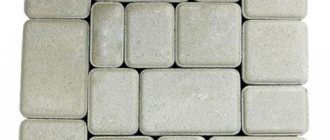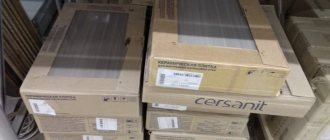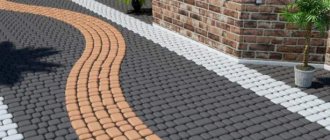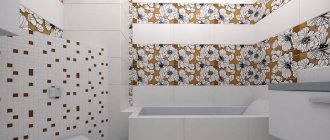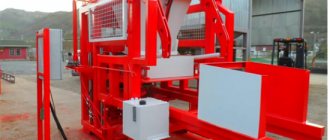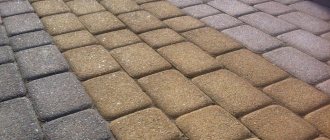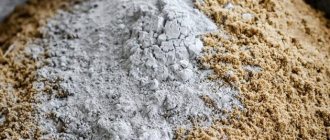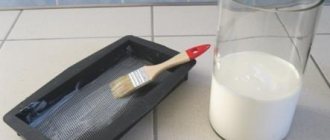- home
- Concrete Products
- Paving slabs
Reading time: 9 minutes
6849
A water repellent for paving slabs is a special substance that is used to impregnate the coating in order to give it water-repellent properties. First of all, this is necessary for protection from atmospheric moisture, which, if it gets on the paved surface, can cause destruction and deformation of the tiles, deterioration of performance properties, and shortening of service life.
Thus, rain and melt water cannot be completely sterile - they are saturated with industrial emissions, vehicle exhaust gases, weak alkaline and acidic solutions, hydrocarbons, microorganisms, etc. All this gets into the pores of paving slabs, pollutes them, provokes the appearance of stains, changes in color and characteristics.
Treatment with a water-repellent agent allows you to avoid the growth of fungi and mold in the tiles, protects the material from salts being washed out by water and the appearance of efflorescence, increases frost resistance, improves the appearance and extends the service life. Usually, solutions are applied immediately after laying the coating, but they can be treated at any convenient time.
The water repellent penetrates deeply into the material through the pores, creating a water-repellent film on the surface of the tile. Water does not penetrate inside, the coating does not destroy, it looks brighter and fresher, and the possibility of the appearance of efflorescence, microorganisms, moss, etc. is excluded.
Water repellents for paving slabs are sometimes confused with waterproofing, but these are completely different types of protection. In the first case, the material is given the ability to repel water, but while fully maintaining the ability to allow air to pass through and release steam to the surface. But laying waterproofing requires an impermeable layer that protects against constant exposure to water. The water repellent works effectively only under the condition of periodic and short-term exposure to moisture.
- 1 The main disadvantage of paving slabs
- 2 Advantages of processing
- 3 Ways to protect paving slabs
- 4 Technology for creating comprehensive protection
- 5 Popular hydrophobic solutions
- 6 Complex processing
The main disadvantage of paving slabs
hydrophobization for paving slabs
Despite the large number of advantages, paving slabs have one significant drawback - under the influence of moisture, its structure gradually collapses. This material has micropores in the surface, the number and diameter of which depends on the production technology. Moisture gets inside the coating through these pores, so over time the tiles become damp.
In winter, this process is complicated by the fact that water begins to expand when exposed to negative temperatures and form ice, which causes the destruction of concrete. As a result, paving stones lose their performance properties and attractive appearance. Traces of efflorescence form on its surface, which are extremely difficult to remove.
To protect the coating from moisture entering the structure, you can use water repellents for paving slabs.
What is better to use: a shovel or a concrete mixer?
Concrete is quite heavy, so it is advisable to mix it using a concrete mixer. But such mechanization of the process has a significant disadvantage: detergents form foam when intensively mixed. Therefore, you have to stop the electrical equipment so that the foam settles completely. At the same time, the use of a concrete mixer allows you to obtain a high-quality, homogeneous mixture without lumps.
For manual mixing, a shovel and a tray are used. The procedure itself requires a lot of time and enormous physical effort. The latter is compensated by the absence of foam and long downtime due to its formation.
To facilitate the process, it is recommended to mix the solution in a bucket using a construction mixer. This option is only suitable for small-volume construction.
Using a concrete mixer allows you to obtain a homogeneous cement mortar that does not contain lumps at all Source stroy-podskazka.ru
Advantages of hydrophobization
hydrophobization process
Treatment is carried out using special compounds - water repellents. They are applied to the surface of the tile after it is laid. The peculiarity of this solution is that it allows the coating to “breathe”. As a result, concrete is reliably protected from high humidity and retains the ability to evaporate excess moisture into the surrounding space.
The main advantages of the hydrophobization procedure:
- the service life of the tiles increases;
- the frequency of material repairs is reduced;
- the surface is reliably protected from liquid getting into cracks and chips;
- prevents the occurrence of salt traces;
- the resistance of concrete to abrasion increases.
In addition, hydrophobization makes the surface rougher, so it will be easier for ice to break off. At the same time, water repellents have a positive effect on the appearance of paving slabs.
The modern building materials market offers compositions with which you can create the effect of raw stone.
Proportions of materials
When making plasticizers yourself, it is important to strictly observe the ratio of components. For 20 kg of cement it is recommended to use:
- 30 ml washing powder;
- 25 ml liquid soap;
- 10 ml shampoo;
- 5 ml dish soap;
- 50 g soap.
The volume of lime used should be 5 times less than cement.
It is necessary to add powdered additives only after thoroughly mixing the cement, sand and crushed stone. Liquid is added at the end. Detergents are first diluted with water, then the homogeneous composition is poured into a container to mix the solution.
Popular formulations
types of brands of solutions for hydrophobization
The modern construction market offers many brands of hydrophobization solutions. Among them are the most popular and high-quality ones.
For example, Voka brand water repellent has a long service life. This composition penetrates deeply into the concrete structure (up to 3-5 mm). The service life of this material exceeds 10 years.
The mixture from is also in considerable demand. The most popular composition from this manufacturer is the water repellent CT10, which contains silicone. At an affordable price, this composition allows you to achieve the effect of raw stone and protects the paving stones from negative external influences. The manufacturer of this composition states that one layer of the product will be enough for the full operation of the tile.
Another popular mixture is Tiprom K. This water repellent has durability and good protective qualities. Impregnation also allows you to create the effect of wet stone and provides a comprehensive protective effect.
When choosing a composition among the best, which one to choose and how to use it depends on the operating conditions and financial capabilities. Experts recommend paying attention to the following mixtures:
- "Aquasil". A concentrated mixture that reduces the ability of porous and heavy materials to absorb moisture. This water repellent is universal, so it can be used not only for treating paving slabs, but also brick, marble and many other products. The application of this composition not only allows you to achieve good moisture protection of the material, but also increases its strength. Aquasil is fire-resistant. The service life of the frozen mixture reaches 10 years.
- "Spectrum 123". A concentrated substance designed to protect porous materials from the destructive effects of moisture. The product copes well with pathogenic bacteria and traces of mold. Spectrum 123 dries within 20 hours. Contains silicone, which effectively fills all coating defects, including cracks and crevices. The instructions for use of Spectra 123 state that it must be applied only to dry surfaces and at temperatures above 0°C.
- "Tiprom U". In terms of its technical characteristics, this product resembles Aquasol. It repels moisture and dirt from the surface and prevents the formation of efflorescence. The manufacturer positions this product as a product for non-absorbent materials that constantly interact with water, so Tiprom U can be used to treat sidewalk paths near ponds and swimming pools. The composition can penetrate 30-35 mm deep into concrete, clogging the capillaries of the material. The average consumption of the product is from 150 to 300 ml/m².
- "Armocryl-A". Water repellent, characterized by deep penetration into the concrete structure. It is produced on the basis of polycrylates, so experts classify it as a group of impregnating varnishes. "Armocryl-A" is suitable for processing pigmented tiles, stone, sectional fencing and other structures that are constantly exposed to ultraviolet radiation. The pigmented coating treated with this mixture will not fade. In addition, Armocryl-A increases the strength of cement and concrete joints.
- Alpa Polyfluid. Imported water repellent with excellent penetrating ability. It contains synthetic resins, antifreeze and fungicidal fillers. The product is designed to enhance the protection of porous materials. To apply it, it is better to use a brush; this will allow you to thoroughly treat all hard-to-reach areas. The principle of operation of the composition resembles penetrating liquids, because it crystallizes in microcracks in the coating upon contact with moisture. Among the disadvantages of this water repellent from a French manufacturer, consumers highlight its high cost.
Complex processing
In addition to the use of water-repellent compounds, there is a technology for comprehensive coating protection. In such a situation, processing involves the following steps:
- surface cleaning and local repair work;
- treatment of the coating with a hydrophobization compound, which will protect the concrete from moisture;
- application of auxiliary decorative material.
As an additional layer (for decoration), a special varnish mixture is used for external cladding. This allows you to achieve the most attractive appearance of the finished coating.
Main advantages of integrated technology:
- the material's resistance to moisture increases;
- the tile's resistance to ultraviolet radiation and other atmospheric phenomena increases;
- the service life of tile products increases;
- the aesthetic component improves - after applying a decorative varnish solution, the effect of a wet stone appears on the surface.
Types of waterproofing products
Paints and varnishes to make the tiles moisture-proof and wear-resistant:
- Alkyd (for concrete). Advantages: high level of resistance to mechanical and chemical influences. Disadvantage: pungent odor that does not dissipate for a long time.
- Polyurethane. Advantages: wear resistance, resistance to aggressive chemicals.
- Epoxy. Advantages: impart anti-slip properties, have high strength. The disadvantage is the small selection of colors.
- Rubber. Advantages: high elasticity, resistance to temperature changes, odorlessness, environmental safety.
- Chlorinated rubber.
Another option for waterproofing road surfaces is liquid glass treatment. It can only be used to cover vibro-cast concrete paving stones and slabs. Liquid glass is used for additional waterproofing or to give the surface a glossy shine. In the second case, you will need a large amount of product. The disadvantage of liquid glass is a decrease in color brightness for some time.
Wet stone
Composition application technology
Even a person without specific knowledge and skills can perform hydrophobization. Before processing, you must make sure that the tile products are not damaged. If there are defects, you need to perform local repairs, and then proceed to the main processing.
Hydrophobization is carried out according to the following scheme:
- First, you need to carefully read the instructions for using the water repellent, in which all important points should be noted.
- The coating is thoroughly cleaned of dirt, dust and debris. If necessary, the path is repaired.
- It is recommended to resort to this procedure in dry and warm weather. In addition, it is advisable to apply the compositions to dry tiles, otherwise the effectiveness of hydrophobization will decrease.
- If the mixture must be applied to a wet coating, special compounds must be used for this.
- The water repellent must be applied in 2 layers. Before applying the next layer, the previous one must be completely dry. This takes about 2-3 hours.
- The composition can be applied using a roller, brush or spray.
When processing cracks and chips, it is recommended to apply an additional layer.
What does applying protective agents provide?
applying impregnation for hydrophobization
The use of water repellents gives the following:
- reducing the sensitivity of paving slabs to repeated “thaw-freeze” cycles;
- savings on varnishes and primers;
- reduction in heat transfer;
- preventing the formation of fungi, mold, algae and other pathogenic microflora;
- prevention of efflorescence;
- increasing the resistance of the material to frost;
- increasing the fire resistance of the material;
- increasing the moisture resistance of the coating;
- preservation of gas and vapor permeability properties.
Rules for working with a concrete mixer
Having turned on the equipment for mixing concrete, it is necessary to evenly fill it with the main components of the solution.
When calculating the amount of each ingredient, you need to focus on the displacement of the mixer. In the calculation we focus on the volume of one shovel. If we start from the standard recipe, which is used in the manufacture of mortar for paving slabs with high frost resistance and a thickness of 4.5 cm, then the composition of the mixture will be as follows:
- 22 kg of cement;
- 54 kg of crushed stone;
- 19 kg of sand;
- 9 liters of water;
- 110 gr. plasticizer.
The first step is to fill the concrete mixer with sand . The operating mode should be as follows: five shovels are loaded into the equipment, after which 20 seconds are taken to rest. Along with sand, you need to add dye to the concrete mixer. Its amount should not be more than 6% of the volume of cement.
Then you need to add crushed stone to the concrete mixer , followed by cement. The homogeneity of the resulting mixture must be checked visually. After this, add water, followed by diluted plasticizer.
Attention must be paid to the volume of water poured into the concrete mixer and the dosage of plasticizer, the amount of which should not exceed the calculated amount. To complete the work, you need to add polypropylene fibers, six hundred grams. There is enough fiber for one m3.
Which water repellent for tiles to choose
Polyfluid Alpha
Tiprom K
Tiprom U
When selecting a water repellent, the following criteria must be taken into account:
- what coatings the composition will be applied to (dry or wet base, material structure);
- the effect that needs to be achieved after hydrophobization;
- manufacturer;
- nuances of use.
Tips for using impregnation
When hydrophobizing, experts recommend following the following rules:
- tiles should only be processed at positive temperatures;
- after finishing the treatment, the surface should be covered with light material for 24-36 hours;
- the mixture must be applied evenly to the coating, without leaving untreated areas;
- the base for the water repellent must be thoroughly cleaned of dirt;
- The mixture must be applied until the coating stops absorbing liquid.
The interval between repeated treatments depends on the composition of the product. The average service life of the coating is 10 years. During this period, the tiles will be reliably protected from mold, mildew and other manifestations of high humidity.
To check the properties of the water repellent after application, after it has dried, it can be moistened with water. If the liquid rolls off the material, it means the processing was done correctly.
How to use it correctly
Plasticizing impurities (liquid or powder) must be added to the solution according to the manufacturer's instructions. If the additive is made in powder form, it must first be diluted with water or added to a concrete mixer while mixing the ingredients.
Method of using liquid plasticizer S-3:
- Mix the solution thoroughly in the packaging container.
- Measure out the additive (per 1 quintal of cement): 1/2-1 l - for moving concrete, 1-2 l - for self-compacting concrete, then dilute with water.
- Pour the resulting liquid into a running concrete mixer, load the required amount of cement.
- Add solid aggregate and stir the mixture until smooth.
If too much plasticizing admixture is added to the original concrete composition, it will harden for a long time.
It’s easier to work with a ready-made liquid additive: you don’t need to dilute it in a certain proportion and spend time on infusion Source prostroymaterialy.com
